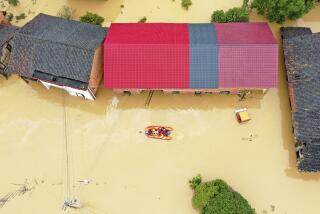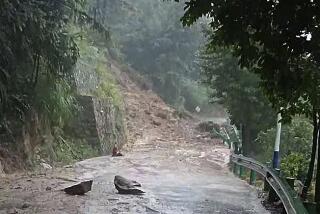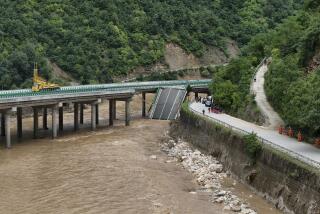Flooding in China Displaces More Than a Million People
- Share via
BENGBU, China — Zheng Huaineng, a 66-year-old melon farmer from a village along the Huai River a few miles from here, has no idea what his land or his house will look like on whatever day he is allowed to return.
But he does know, as he idles away his days in an evacuation center at a school in this eastern industrial city, that he is not alone in his predicament. He is one of more than a million Chinese who have been relocated in recent days due to torrential rain and flooding.
Record-high water levels here in Anhui province, where the Huai wends its way toward the Yellow Sea, have led engineers to blow up at least eight big dikes in rural areas in a bid to keep the water from flooding more highly populated areas. In such cases, they have been able to carry out relatively orderly evacuations. But sometimes, the water has come on so fast that it has proved deadly.
Floods are a virtually annual summer calamity in China, and this year they have been severe in the eastern, central and northwestern parts of the country. The latest official estimate of flood-related deaths, on July 11, put the toll at 569. Since then, about 140 more people have been reported missing and are presumed dead. These include 49 people, mostly tourists at a mountain resort, who are believed to have been killed in a storm-induced landslide in Sichuan province last weekend.
Parts of Sichuan and Shaanxi provinces have reported the worst flooding since 1964. Tens of thousands of homes have been destroyed, and stretches of the national highway system have collapsed. Floods in at least four coal mines in the country have stranded 33 workers, with little hope for their survival. More than 1,000 people fled their homes in Wuhan, in east-central China, after the Yangtze River breached or destroyed dikes.
Even as several rivers have been reported at record-high crests, and authorities report an especially high number of mud-, rock- and landslides, the death toll is still well below last summer’s, when 1,500 people were killed. That summer was the worst since 1998, when near nonstop rain on the Yangtze and other rivers produced flooding that killed 4,000 people.
The rain has let up somewhat in the last few days, bringing a measure of relief. Officials, however, warn that new storms could bring about more death and destruction. Economic losses -- mainly damage to crops -- have already hit an estimated $3.7 billion.
One reason that the death toll has not been higher is the controlled destruction of dikes, which has kept high water from inundating big industrial cities such as Bengbu, about 500 miles south of Beijing.
On the other hand, it is likely to cause even worse havoc in upriver farming villages such as Changhui. That is where Zheng lives. Like millions of other Chinese, Zheng lives on land that was reclaimed from rivers and lakes through an elaborate dike system.
He had to leave in a hurry last week when soldiers showed up and said the dike would soon be destroyed. He and his wife threw some belongings into a cart, loaded that aboard a truck and came to the evacuation center.
“They needed to do it to save lives, I understand that,” said Zheng, whose temporary home is a first-floor dormitory room at the Cai Mao Gan Xiao trade school, which he shares with his wife, Huo Meixuan. “They are taking very good care of us here. I just hope I can go back to farming someday.”
Several hundred of his fellow villagers are also living in the dormitory, their belongings piled on carts and tractors parked along the school’s basketball courts, around which children dart and elders gather to smoke and talk. A red and gold banner strung across the entrance to the school welcomes “people from the relocation project along the Huai River.”
“I want to go back as soon as possible, and see what we have to do to rebuild,” Zheng said. “But for now, we have nothing to do all day. We just wait.”
Zhang Fenglei, an official with the Bengbu government’s flood control and drought relief office, said river levels were at a 50-year high this summer, with an estimated 417,000 people in the province either temporarily stranded or relocated. Thousands of people were staying in tents on tops of river dikes not targeted for destruction and considered safe for temporary habitation, he said.
Another official with the office, Dong Yuguo, said it was unclear when people would be able to move back.
“Of course we hope they can move back as soon as possible, and the farmers also hope to get back because they have a deep attachment to their land,” Dong said. “But Mother Nature’s plans are uncertain.”
*
Zhang Xiuying of The Times’s Shanghai Bureau contributed to this report.
More to Read
Sign up for Essential California
The most important California stories and recommendations in your inbox every morning.
You may occasionally receive promotional content from the Los Angeles Times.










